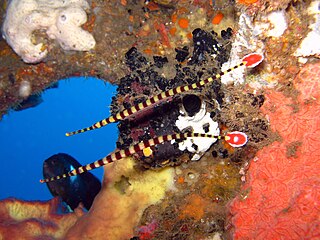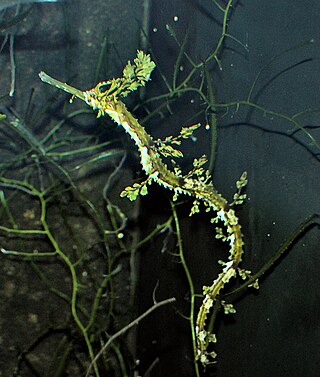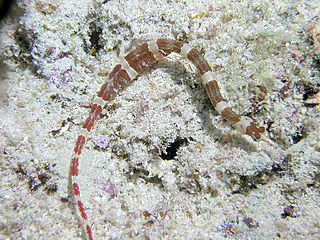
Pipefishes or pipe-fishes (Syngnathinae) are a subfamily of small fishes, which, together with the seahorses and seadragons, form the family Syngnathidae.

The greater pipefish is a pipefish of the family Syngnathidae. It is a seawater fish and the type species of the genus Syngnathus.

The banded pipefish or ringed pipefish is a species of fish in the Syngnathidae family.

Schultz's pipefish, Corythoichthys schultzi, is a pipefish of the family Syngnathidae.

The messmate pipefish is a species of marine fish in the family Syngnathidae. It is widespread throughout the tropical waters of the Indo-Pacific region, from the eastern coast of Africa to the Vanuatu Islands. This species can reach a length of 19.8 cm. It occasionally makes its way into the aquarium trade where it is known as the dragonfaced pipefish. Other common names are bloodspot pipefish, reef pipefish, reeftop pipefish and yellow-streaked pipefish.

Corythoichthys intestinalis, known commonly as the scribbled pipefish, is a species of marine fish in the family Syngnathidae. Other common names used include banded pipefish, Australian banded pipefish, Australian messmate pipefish and messmate pipefish.

The ribboned pipefish, ribboned pipehorse or ribboned seadragon, is a species of pipefish found along the coast of northern Australia and New Guinea in habitats ranging from shallow and weedy to deeper and sandy bottoms down to depths of 16.5 m (54 ft). This species grows to a total length of 30 cm (12 in). Their colors can range from greenish yellow to brownish red. This species is the only known member of its genus.

The snake pipefish is a species of pipefish, from the family Syngnathidae, native to the northeastern Atlantic Ocean where they are generally found amongst algae close in to shore. It is the largest species of pipefish recorded in European waters and has spread into arctic waters in the early 2000s.

Corythoichthys amplexus, known commonly as the brown-banded pipefish, is a species of marine fish in the family Syngnathidae.
Hippichthys cyanospilos, commonly known as the blue spotted pipefish or bluespeckled pipefish, is a marine fish belonging to the family Syngnathidae, native from the Indo-Pacific area.

Corythoichthys flavofasciatus, known commonly as the network pipefish, reticulate pipefish and yellow-banded pipefish, is a species of marine fish in the family Syngnathidae.

Stigmatopora argus, the spotted pipefish, is a species of ray-finned fish from the family of pipefish and seahorses (Syngnathidae). The scientific name of the species is the first validly published in 1840 by Richardson.

Corythoichthys benedetto, commonly known as Benedetto's pipefish, is a species of marine fish of the family Syngnathidae. It inhabits the Indo-West Pacific, near Thailand, Myanmar, Indonesia, Papua New Guinea, and Australia. It is found on algae-covered rocky surfaces and gorgonian sea fans at depths of 5 to 20 metres, where it can grow to lengths of around 7 centimetres (2.8 in). It is usually found alone, although it can be found in groups of up to four individuals. This species is ovoviviparous, with males brooding when they are at lengths of 5 to 5.5 centimetres. The specific name and common name honour the late Italian prime minister Benedetto Craxi (1934-2000).
Corythoichthys insularis is a species of marine fish in the family Syngnathidae. It is found in the western Indian Ocean, from the Amirante and Comoros islands to the Maldives. It inhabits coral and rocky reefs at depths of 20 to 45 metres, where it can grow to lengths of 10 centimetres (3.9 in). This species is ovoviviparous, with sexual maturity being reached at 8.2 centimetres (3.2 in). The male carries the fertilised eggs in a brood pouch located under his tail.

Corythoichthys nigripectus is a species of marine fish of the family Syngnathidae. It is found in the Indo-Pacific, from the Red Sea, Indonesia and the Philippines to the Society Islands, Guam and New Caledonia. It inhabits coral reefs and algae patches at depths of 5–30 metres (16–98 ft), where it can grow to lengths of 11 centimetres (4.3 in). This species is both monogamous and ovoviviparous, with males carrying eggs and giving birth to live young.
Corythoichthys paxtoni, commonly known as Paxton's pipefish, is a species of marine fish of the family Syngnathidae. It is endemic to the Coral Sea, being found in the Great Barrier Reef, the Chesterfield Islands, and New Caledonia. It inhabits coral reefs and rubble lagoons to depths of 18 metres (59 ft), where it can grow to lengths of 13 centimetres (5.1 in). This species mates monogamously and is ovoviviparous, with males carrying eggs until giving birth to live young.
Dunckerocampus chapmani is a species of marine fish of the family Syngnathidae. It is endemic to New Caledonia, where it inhabits shallow lagoons to depths of 0–8 metres (0–26 ft). It has only been recorded in the vicinity of the city of Noumea. It can grow to lengths of 8.5 centimetres (3.3 in). It is expected to feed on small parasitic crustaceans that grow on other fishes, similar to most other members of its genus. This species is ovoviviparous, with males carrying eggs and giving birth to live young. The eggs of D. chapmani are particularly large, meaning that only 30 per brood are produced, which is quite low for a pipefish. Males may brood at 8 centimetres (3.1 in).

Dunckerocampus pessuliferus, occasionally Doryrhamphus pessuliferus, is a species of marine fish of the family Syngnathidae. It is a coastal species, inhabiting waters around the Coral Triangle, including the Philippines, Indonesia, and northwestern Australia. It lives in coral patches on sandy and muddy slopes at depths of 15–44 metres (49–144 ft), where it can grow to lengths of 16 centimetres (6.3 in). It is an active cleaner, feeding off of parasitic crustaceans growing on other fishes. The adult fish form pairs and are normally observed swimming along the bottom around large remote coral heads on muddy slopes. This species is ovoviviparous, with males carrying eggs and giving birth to live young.
Hippichthys spicifer, commonly known as bellybarred pipefish, banded freshwater pipefish, or blue spotted pipefish, is a species of pipefish of the family Syngnathidae. It is found in the Indo-Pacific, from the Red Sea and East Africa to Sri Lanka and Samoa. It lives in shallow coastal and estuarine habitats such as mangroves, tidal creeks, and the lower reaches of rivers, where it can grow to lengths of 18 centimetres (7.1 in). It is expected to feed on small crustaceans and mosquito larvae. This species is ovoviviparous, with males brooding eggs in a brood pouch before giving birth to live young. It is reproductively active all year, with males and females reaching sexual maturity at 10.8 and 10 centimetres respectively. Brood size can vary significantly, from 114 to 1764, with an average of 604.4 plus or minus 322.8.

Corythoichthys conspicillatus, the reticulate pipefish, is a species of pipefish from the family Syngnathidae.
















